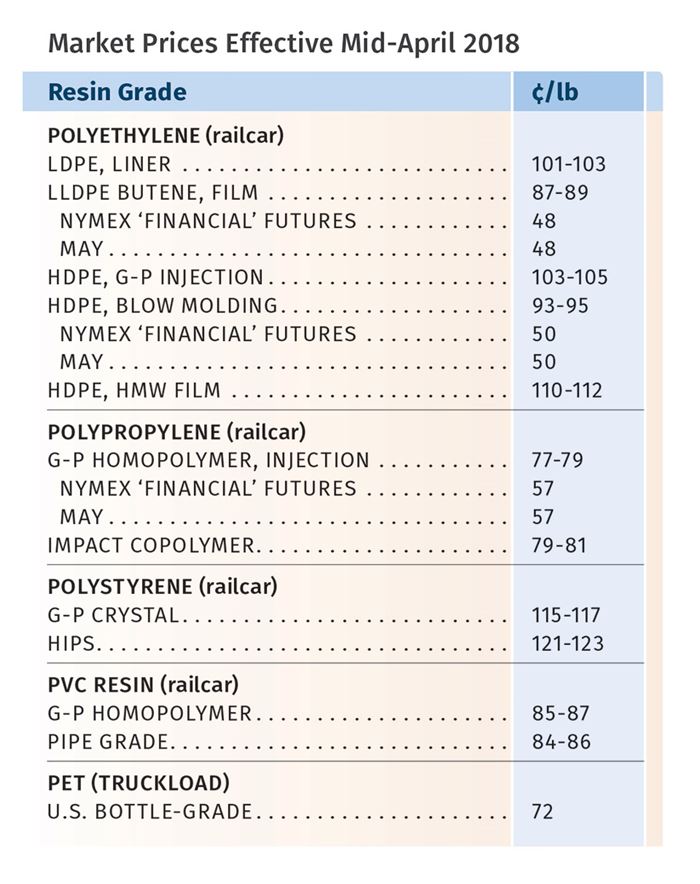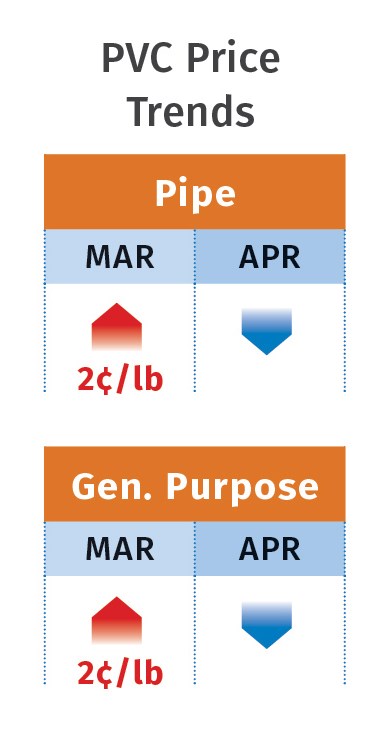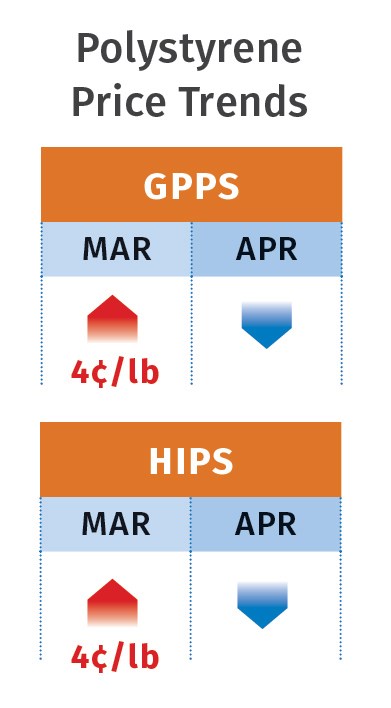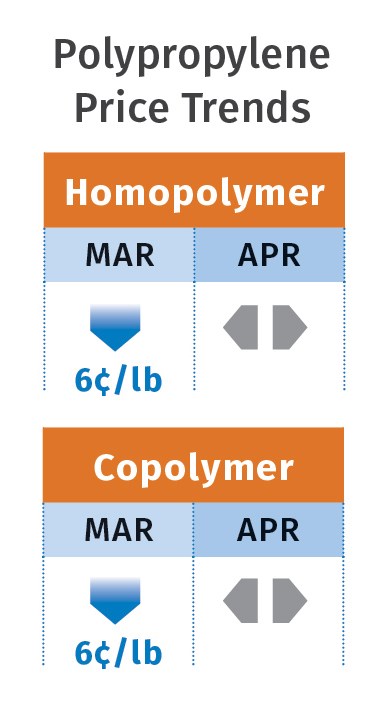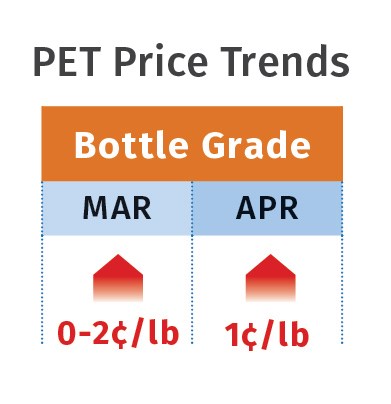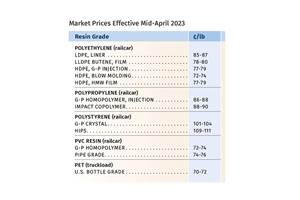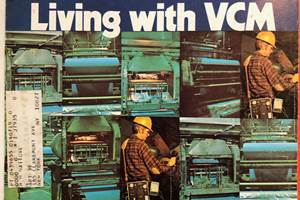Mixed Bag for Commodity Resin Prices
Following price increases for most resins except PP, a flat-to-downward trajectory emerged.
While PS, PVC and PET prices moved up in March, a reversal of those increases was expected by this month. Driving prices back down was a combination of falling feedstock costs and improved monomer and polymer availability. Meanwhile, PE prices remained flat despite a March increase that was delayed until April but did not appear to have teeth. If anything, there was potential for continued flat or even lower prices going into May.
The exception was PP, with a double-digit drop going into April. Falling feedstock prices, a drop in export demand, and some improvement in material availability were among the drivers, though a margin-expansion price hike was looming for May.
These are the views of purchasing consultants from Resin Technology, Inc. (RTi), Fort Worth, Texas, CEO Michael Greenberg of the Plastics Exchange in Chicago, and Houston-based PetroChemWire (PCW).
PE PRICES FLAT TO LOWER
Polyethylene prices were flat in March and were expected to remain so in April, with potential even for some downward movement this month, according to Mike Burns, RTi’s v.p. of client services for PE. Burns, PCW, and The Plastic Exchange’s Greenberg all wagered that suppliers might aim to push through the 3¢/lb March increase in April, but they doubted such a move would succeed.
“Producers will take another shot in April, but processors feel the top of the PE market might already be in place,” reported Greenberg. PCW noted that pricing momentum appeared lost amid soft domestic demand. Both sources characterized spot PE prices as flat to lower, with weakened buying activity on both the domestic and international fronts. Greenberg reported particular weakness and decline of as much as 4¢/lb for LDPE and LLDPE injection grade as more material has become available Said Burns, “Global PE prices were much lower heading into April, as there’s a lot of supply available. Also, China is not importing any resin right now, which has been clogging things up.”
Burns emphasized that North American PE prices must remain no more than 7-10¢/lb above the global price level to retain export demand. He noted that off-grade PE prices are back down to pre-Hurricane Harvey levels, while spot ethylene monomer prices in March were near a 10-year low.
Burns expected “a lot of pricing discussions” at NPE2018 this month in Orlando, Fla. “Processors are now paying 14¢/lb more, than they expected in late 2017 when doing their budgets. They thought prices would drop by 3¢ this year and instead, prices went up 11¢/lb.” Still, he foresaw downward pressure going into this month but did not expect a major decline—say, on the order of 3¢/lb.
PP PRICES DROP
Polypropylene prices dropped another 6¢/lb in March, in lock step with propylene monomer contracts, following the 6¢/lb drop in February. While late-settling April monomer contracts were expected to be flat to down by 1-2¢, several PP suppliers had issued price increases of 3-5¢/lb for April 1.
Industry sources were doubtful about full, if any, implementation of such increases. RTi’s v.p. of PP markets, Scott Newell, noted that the proposed April hike is an attempted margin increase. He expected PP prices in April would be close to flat—plus or minus at most 1-2¢/lb. He expected similarly stable pricing in May, barring any major unplanned occurrence. He noted that PP suppliers claimed supply tightness and being sold out, though plant utilization rates were under 80% of capacity for the first two months of the year. Newell expected an increase in production rates and in demand between March and May, thereby returning at least to normal levels.
There were some contrary indicators, however. PCW reported that PP spot prices were steady, though availability of prime material was limited because of low operating rates in the first quarter. The Plastics Exchange’s Greenberg reported that spot market demand was off as buyers anticipated further price decreases, even though suppliers with very little inventory feel otherwise. Regarding the announced price increase for April, he noted, “It has been a while since a margin-enhancing increase has held, but fundamentals are currently leaning toward some level of success.”
PS PRICES UP, THEN DOWN
Polystyrene prices generally moved up 4¢/lb in March, as suppliers forced through an increase. The move was attributed to tight styrene monomer supplies due to unplanned outages. However, both PCW and Mark Kallman, RTi’s v.p. of client services for engineering resins, PS and PVC, were projecting a short life for that increase.
Kallman expected a falloff of at least 1-2¢/lb in PS prices in April, with the rest the March 4¢ increase slipping away by early May. PCW reported that overall spot PS availability was adequate, as the first-quarter monomer outages appeared to be having minimal impact on PS operations.
“The U.S. styrene supply situation was loosening up significantly,” PCW reported. Kallman noted that benzene contract prices for April dropped 7¢/gal to $2.99/gal, while March ethylene contracts were expected to drop for a second consecutive month by another 1-1.5¢/lb. Another month of declines was considered likely for both chemicals. Kallman expected PS prices to remain flat in May.
PVC PRICES UP, THEN FLAT
PVC prices appeared to have moved up 2¢/lb in March, following implementation of the February 3¢/lb price hike. PCW reported that while suppliers were still aiming to pursue in April the remaining 2¢ of their March 4¢ hike, it appeared that neither this nor an attempt by two suppliers for a new April increase would be implemented. RTi’s Kallman also ventured that the 2¢/lb already gained would come off in April due to improved PVC capacity following planned maintenance turnarounds. Kallman also cited lower ethylene contract prices, a softening in export demand with lower prices abroad, and a delay in the construction season due to weather conditions.
He predicted stable prices for May, barring sharp demand spikes. PCW indicated that suppliers would aim to hold onto their total of 5¢ in price hikes as long as possible.
“Their hope is to repeat last year’s feat of stable pricing for six months. The consensus in the market is that their success will be determined in large part by what happens in the ethylene market, as continued weakness in ethylene pricing will undoubtedly put pressure on PVC prices.”
PET PRICES FLAT-TO-DOWN
PCW reported that domestic bottle-grade PET resin started April at 72-74¢/lb truckload and railcar delivered Midwest, up 1¢/lb from March. However, prices were expected to be flat or to drop 1-2¢/lb during April, driven by falling feedstock costs and a steady supply from domestic production and imports. Meanwhile, imported PET with an IV of 78 or higher was at 69¢/lb delivered duty-paid (DDP) to the West Coast, and 72¢/lb DDP to the East Coast, no change from March 1.
Anti-dumping duties were slated to be imposed on U.S. PET imports from South Korea, Indonesia, Taiwan, Brazil and Pakistan in late April. This was expected to produce an overall drop in imports starting in May and through the summer as those five countries accounted for about 42% of all U.S. PET imports in 2017.
Related Content
PP Prices May Plunge, Others Are Mostly Flat
PP prices appear on the verge a major downward trajectory, with some potential of a modest downward path for others.
Read MoreBaxter to Scale Up PVC Intravenous Bag Recycling Program
Successful pilot program with Northwestern Medicine will expand to additional units and health systems.
Read MorePrices of Volume Resins Drop by Year-End
Entering 2025, prices of major commodity and volume resins are generally in a ‘buyer’s market.’
Read MoreVCM in the News Again, Not in a Good Way
Those three letters, V-C-M, stood out from the headlines of the toxic train wreck in Ohio this past week — bringing up echoes of a time that few may remember today, when the vinyl industry was in an uproar over reports of VCM hazards in the workplace and possibly in PVC food packaging.
Read MoreRead Next
For PLASTICS' CEO Seaholm, NPE to Shine Light on Sustainability Successes
With advocacy, communication and sustainability as three main pillars, Seaholm leads a trade association to NPE that ‘is more active today than we have ever been.’
Read MoreBeyond Prototypes: 8 Ways the Plastics Industry Is Using 3D Printing
Plastics processors are finding applications for 3D printing around the plant and across the supply chain. Here are 8 examples to look for at NPE2024.
Read MorePeople 4.0 – How to Get Buy-In from Your Staff for Industry 4.0 Systems
Implementing a production monitoring system as the foundation of a ‘smart factory’ is about integrating people with new technology as much as it is about integrating machines and computers. Here are tips from a company that has gone through the process.
Read More

